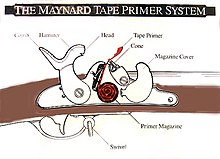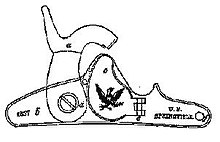Contents


The Maynard tape primer was a system designed by Edward Maynard to allow for more rapid reloading of muskets.

Invention
Muskets in the early 19th century were flintlocks, which had a high rate of misfire and performed poorly in damp and humid weather. In 1807 the first percussion ignition system was patented by Alexander Forsyth based on research on fulminates conducted by Edward Charles Howard, but practical percussion lock systems did not become available until the 1820s, after Alexander John Forsyth's patent had expired.
Percussion cap systems relied on small copper caps that were filled with mercury fulminate. While they greatly improved the reliability of muskets and their performance in damp weather, the slow rate of fire of muskets was still an issue. In 1845,[1] Dr. Edward Maynard, a dentist with an interest in firearms, embedded tiny pellets of priming material in thin strips of paper, then glued a second strip of paper on top of the first, creating a "tape" of primer. The tape could be manufactured quickly and cheaply, since paper was much less expensive than copper. Maynard also developed an automatic feeding system that would advance the tape when the musket's hammer was cocked. The hammer not only detonated the primer, but would also automatically cut the paper, thus removing the spent portion of the primer tape.
Initial reception

Maynard's new system still required the musket's powder and Minié ball to be loaded conventionally into the barrel, but the tape system meant that the percussion cap no longer needed to be manually loaded onto the percussion lock's nipple.[2][3] This saved the soldier a step during the reloading process, which increased the soldier's overall rate of fire.[2]
The Ordnance Board was initially hesitant about the design, but the secretary of war, future Confederate President Jefferson Davis, was so enthusiastic about the design that it was installed on the Springfield Model 1855 rifle-musket.
Performance in the field
The Maynard tape worked well as long the tapes were kept dry,[1] proving to be fragile in comparison to copper caps,[4] and unreliable under bad weather conditions.[3] In 1860, the Maynard system was deemed by the War Department as unreliable and abandoned.[5] The M1855 was designed to use either the Maynard system or standard percussion caps, and so remained functional even with the problems of the Maynard system.[2]
Variations of the Maynard tape system are still used today in modern toy guns.[4]
References
- Pauly, Roger (2004). Firearms: The Life Story of a Technology. Greenwood Publishing Group. ISBN 978-0-313-32796-4
- Coggins, Jack (2004). Arms and Equipment of the Civil War. Courier Dover Publications. ISBN 978-0-486-43395-0
- United States Army Infantry School (February 1942). "From Flintlock to M-1 (A Review of U.S. Infantry Shoulder Weapons)". The Infantry School Mailing List. 23. Fort Benning, GA: Academic Department of the Infantry School. Retrieved 17 January 2024.
- Wooster, Robert (1991). History of Fort Davis, Texas. Division of History, Southwest Cultural Resources Center, Southwest Region, National Park Service, Department of the Interior. Retrieved 17 January 2024.
- Smithsonian (1 April 2014). Firearms: An Illustrated History. DK Ink. ISBN 978-1-4654-3089-2.
- ^ a b United States Army Infantry School 1942, p. 19.
- ^ a b c United States Army Infantry School 1942, pp. 19−20.
- ^ a b Wooster 1991, p. 69.
- ^ a b Smithsonian 2014, p. 81.
- ^ United States Army Infantry School 1942, p. 20.

